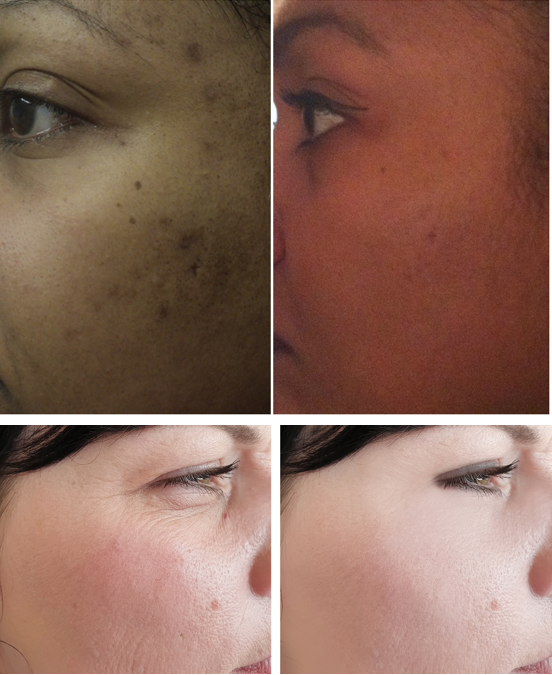OBAGI BLUE PEEL AND CHEMICAL PEELS

OBAGI BLUE PEEL AND CHEMICAL PEELS
Today in the U.K, peels are among the most popular aesthetic treatments out there. Why? Because peelings are the best way to renovate the skin! Unlike the mechanical peeling that is done at home, the chemical peel is practiced by an aesthetician. To restore radiance to the dull complexion, to fade spots, or smooth the skin by reducing the relief of wrinkles … there is no limit to what chemical peels can solve.
The stronger the peel, the more effective it is, but the peel required depends on each patient. A light peel will only work on a superficial layer, which is the epidermis. With a stronger skin peel, we will be able to reach the dermis where the collagen fibers and the melanocytes lie. Usually, patients are not sure what the differences are and what the best treatment for them is. That’s why useful information on this topic is essential. Discover in this article of the Dr Fern Mag everything you need to know about the Obagi facial peels, the Obagi Blue Peel, and the Obagi Blue Peel Radiance! Find the fresh complexion and smooth skin that you’ve always wanted!
The Obagi Blue Peel Radiance (BPR) is one of the best peels on the market, which I recommend to my patients and love using it on myself! Obagi BPR is made from 20% based salicylic acid skin peel and can improve various areas of the body that my patients have concerns about, such as:
Oily skin or acne (acne folliculitis).
Pores
Ageing and loosening of the skin
Pigmentary tasks
Reactive Pigmentations
Dull Skin
Acne Scars
Fine lines
Wrinkles
Not only does BPR give you the advantage of correcting areas of concern, but it also brings out a softer and lighter skin. But is this the right peel for you?
HOW DOES OBAGI BPR WORK COMPARED TO OBAGI BLUE PEEL?
So, if you haven’t noticed, Obagi Blue Peel and Obagi BPR work differently, in that the latter is a more superficial peel, whereas Obagi Blue Peel is a deeper TCA chemical peel. Obagi BPR can exfoliate damaged skin layers and rejuvenates the skin by stimulating collagen production. Appointments for the BPR usually last for about 30 minutes, leaving the patients to resume their activities straight after!
With strict adherence to the protocol after the treatment has finished, patients are recommended one peel every two weeks for a total of 5 to 6 sessions, until patients have achieved the desired result and the specific concern has been eliminated. Obagi BPR is suitable for most skin types, and patients usually have it done every 3 to 4 weeks after initial treatment.
Obagi Blue Peel, on the other hand, consists of two phases, namely the application of specific and personalised treatment cream at home and then the application of trichloroacetic acid (TCA) peel, whose dosage depends on what will be diagnosed during the consultation with me.
The action of the creams makes it possible to prepare the skin for peeling to optimise the result. The TCA peel action accelerates cell renewal in the dermis while stimulating collagen production. With a stronger peel, we can reach the dermis where the collagen fibers and the melanocytes are. It solves deeper problems in which the more superficial peel is not able to reach as effectively.
The Obagi Blue Peel considerably improves the firmness and contributes significantly to the rejuvenation of the skin, working deeper on:
Classic skin ageing (fine lines – lack of firmness and radiance)
Hyperpigmented brown spots (age spots, pregnancy mask)
Deep sun lesions
Acne and acne scars
The dilated pores
Melasma
With the Obagi Blue Peel, the skin peels from the 3rd day until the 6th day. The appearance of the skin turns to a “pink” colour for a fortnight, then to resume its normal colour. A visit of control is usually required after eight days of the peeling.
My patients rarely experience any complications with both Obagi BPR and Obagi Blue Peel, especially if they follow post-treatment protocol. However, there have been cases of temporary hyperpigmentation problems. These can be correct through further treatment and skincare products. It is why the Obagi chemical peel range of products should always be administered by professionally trained physicians and is not suitable to be applied by the patient on their own!
Found my information on Obagi Peels useful? Follow me on Instagram, Facebook, and Twitter for the latest tips on Obagi peels! And while you’re at it, why not book a consultation to see me? My assistants will be more than happy to assist you!
Online Facial Consultation is now available. A complete and precise assessment of patient’s needs through Dr Fern’s unique Expertise wherever you are.